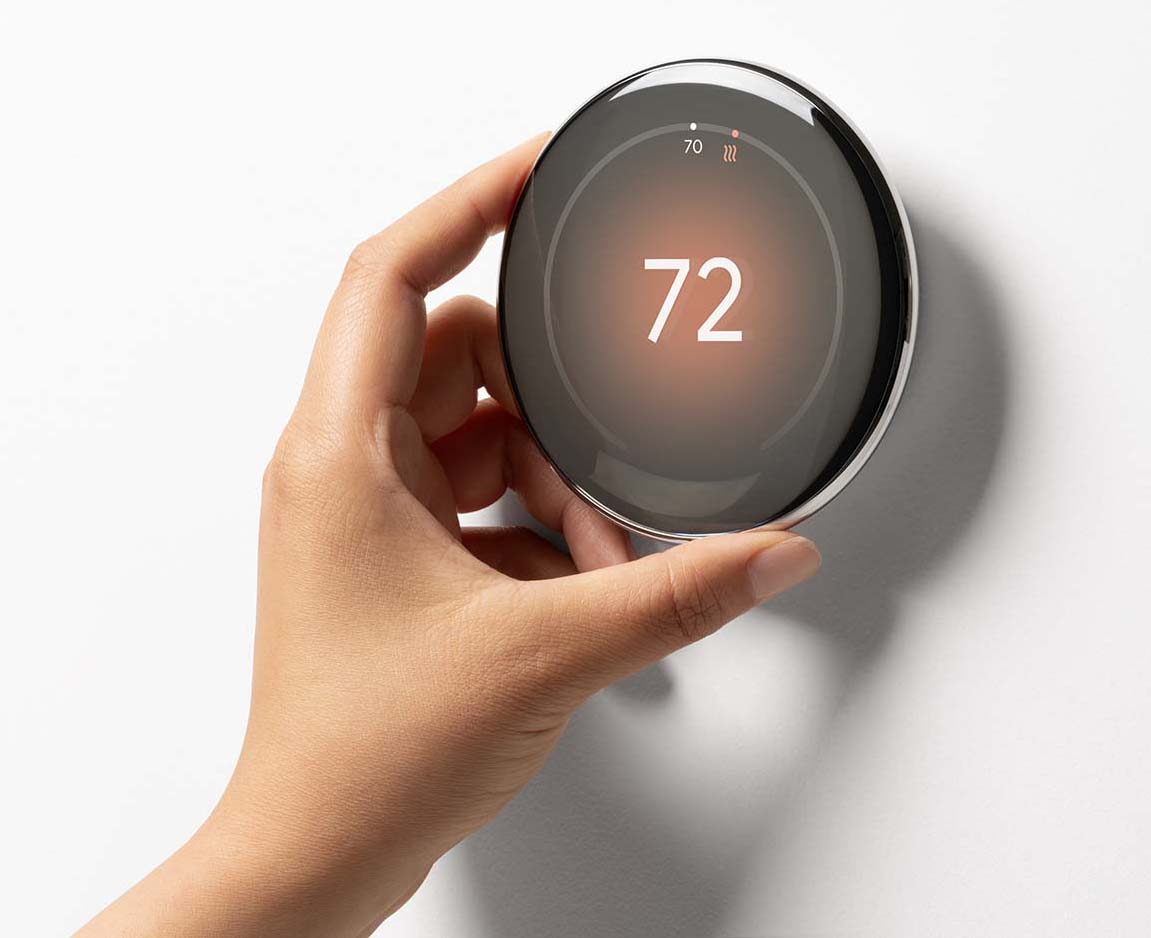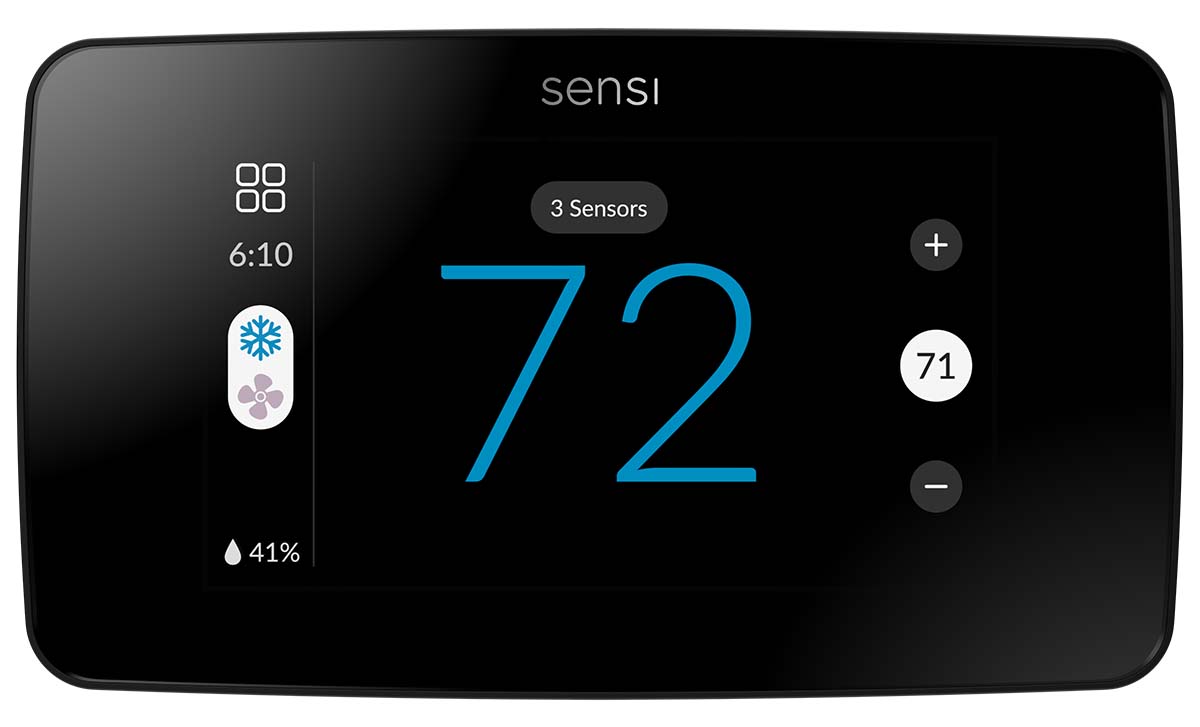✕
– Michael Siemann
distinguished engineer,
Resideo Technologies Inc.
Smart thermostats can help homeowners save on their heating and cooling costs, and thermostat manufacturers say they have receipts for those claims.
Past performance, however, does not guarantee future results, and any given home’s energy and utility bill savings will also depend on a host of other factors, such as the overall energy efficiency of the HVAC system and the home itself, how the smart thermostat’s features are used, the temperature setbacks employed, and the weather outside.
The main energy-saving function of the smart thermostat is the same as that of its older cousin, the programmable: To automatically maintain lower heating temperatures in the winter, and higher cooling temperatures in the summer, during times when the home doesn’t need full comfort conditioning, such as when occupants are asleep, out for the day, or away on vacation.
But smart, connected thermostats offer a greater degree of control over HVAC systems. Some, for example, learn a home’s occupancy patterns, use sensors to prioritize comfort heating and cooling when and where they’re most needed, and enable “geofencing,” which can detect the location of occupants’ smartphones when they’re on their way home and start up the HVAC system to make sure the place is comfortable when they get back.
“There is a significant amount of energy wasted to maintain high levels of comfort when people are not in the home,” said Michael Siemann, distinguished engineer at Resideo Technologies Inc. “The best features to combat this depend on the home’s dynamics: Setpoint schedules are great for homes with consistent occupancy patterns, while geofencing is better when occupancy patterns are more dynamic.”
Resideo
With the use of one of Resideo’s Honeywell Home smart thermostats, Siemann said, the company recommends a high cooling temperature in the summer — 82°F, for example — when no one is at home.
“Our intelligent Adaptive Recovery can bring the home back to comfortable levels before the customer gets home to notice,” he said.
A Resideo study in Indiana and Ohio, Siemann said, found that homeowners with Honeywell Home T5 and T6 thermostats who frequently used the scheduling features saved between 8% and 16% on their heating and cooling energy costs. The savings were calculated on the basis of comparisons to the average annual heating and cooling spending in the U.S. for a single-family house, according to the company’s website.
Marissa Kocaman, a Resideo product manager, said the company offers the Resideo Academy training platform to help contractors “guide clients to take better control of their energy consumption and enhance home comfort.” The courses, taught by senior technical specialists, cover pre-installation site surveys, installation, good practices, and turning over the system to customers, she said.
Resideo also has the Resideo Pro app, which links contractors to their customers’ HVAC systems.
“The Resideo Pro app offers pros the chance to automatically link their business to the homes they serve to retain customers more effectively and makes the handoff to the homeowner quick and more efficient with an interview-based configuration tool,” Kocaman said.
Google Nest

GOOGLE: Google Nest, which just released its fourth-generation Nest Learning thermostat, said users of its smart thermostats save an average of 12% on heating costs and 15% on cooling costs. (Courtesy of Google Nest)
Google Nest introduced its fourth-generation Nest Learning Thermostat in August. The new Nest Learning Thermostat comes with the second-generation Nest Temperature Sensor to help manage hot and cold spots around the home, and uses artificial intelligence (AI) features to more quickly and accurately develop a personalized temperature schedule, the company said.
Independent studies found that the use of a Nest Learning Thermostat saved an average of 12% on heating costs and 15% on cooling costs, according to Kristin Bickett, head of Nest Enterprise Partnerships at Google.
Nest thermostats have several features that help achieve those kinds of savings, said Bickett, including:
- Smart scheduling, which learns the temperatures occupants like, and when they like them, and suggests tweaks to save energy.
- Natural heating and cooling, which uses information about the weather outside to naturally heat or cool the home, as needed, when possible.
- An “adaptive eco” function that adjusts the temperature to save energy when a home is unoccupied, then brings it to a comfortable temperature in time for the occupants’ return. Enabling presence-sensing on smartphones in the household, with the use of the Google Home app, turns on this geofencing feature.
- Energy Shift, which automatically shifts greater energy use to times when energy is cheaper or being generated from cleaner sources. Energy Shift works in conjunction with Nest Renew, a free, membership-based service.
Ecobee
Users of the ecobee smart thermostat in North America can save up to an estimated 26% on their heating– and cooling-related energy costs, according to senior product manager Karthiga Vezhavendan. The estimates are based on comparisons to systems that maintain a consistent, and commonly used, setting of 72°F rather than the energy-saving temperature fluctuations an ecobee thermostat can control.

ECOBEE: Users of ecobee smart thermostats can save up to 26% on heating and cooling costs, the company said. (Courtesy of Ecobee)
Savings can differ according to the efficiency and health of the HVAC system, the building’s windows and insulation, the weather outside, and many other variables.
“There are always going to be a variety of factors, but in general, putting a new ecobee on an existing HVAC system will help optimize savings compared to a hold at 72°F,” Vezhavendan said.
Users of ecobee thermostats should set turndown schedules, using the Comfort Settings function, for best results, Vezhavendan said.
“It’s especially important to set times when you’re away,” she said.
Vezhavendan also encourages users to enable eco+, available with certain ecobee models, a suite of features designed to boost energy efficiency. Those include a time-of-use feature, which preheats or precools the home at times when electricity prices are lower (not available in all areas), and occupancy sensors, which signal the thermostat to adjust the temperature based on whether people are in the home or not.
Vezhavendan said ecobee has a wealth of resources for contractors who install its thermostats, including in-person and virtual training, videos, tutorials, and a contractor support line.
“Our ecobee for Pro team is dedicated to supporting the professional channel,” she said. “We take pride in prioritizing the training and resources needed for contractors to offer homeowners the best experience possible.”
Copeland

COPELAND: Copeland Sensi smart thermostats can save users up to 23% on HVAC-related energy costs, the company said. The Sensi Touch 2, shown here, will yield optimal efficiency when paired with a heat pump, the company said. (Courtesy of Copeland)
Copeland has two thermostat brands: Its traditional and programmable thermostats carry the White-Rodgers name, while the Sensi brand is attached to connected thermostats.
Users of Sensi thermostats can save up to an estimated 23% on HVAC-related energy costs with the use of features such as flexible scheduling, remote access, and usage reports, said Tom Lorenz, director of product management at Copeland.
The estimated savings, Lorenz said, were calculated by taking a nationwide sample of Sensi users who’d made temperature adjustments, or setbacks, averaging 4°F and comparing those results with a sample of systems in which no setbacks had been made.
“Savings vary based on equipment type (and) condition, insulation, climate, and temperature adjustment size (and) frequency,” Lorenz said.
Like others, Sensi-brand thermostats can include features like time-of-use (also called demand-response), scheduling, geofencing, and sensors to monitor the weather outside, Lorenz said. Sensi thermostats can communicate with room sensors to prioritize heating or cooling in places where people are, he said.
The Sensi Touch 2 model, when used with a heat pump, will provide optimal savings, Lorenz said.
Copeland offers free online training in Sensi thermostats for contractors, as well as in-person training at the branch locations of participating distributors, Lorenz said.
Whether you require installation, repair, or maintenance, our technicians will assist you with top-quality service at any time of the day or night. Take comfort in knowing your indoor air quality is the best it can be with MOE heating & cooling services Ontario's solution for heating, air conditioning, and ventilation that’s cooler than the rest.
Contact us to schedule a visit. Our qualified team of technicians, are always ready to help you and guide you for heating and cooling issues. Weather you want to replace an old furnace or install a brand new air conditioner, we are here to help you. Our main office is at Kitchener but we can service most of Ontario's cities
Source link


